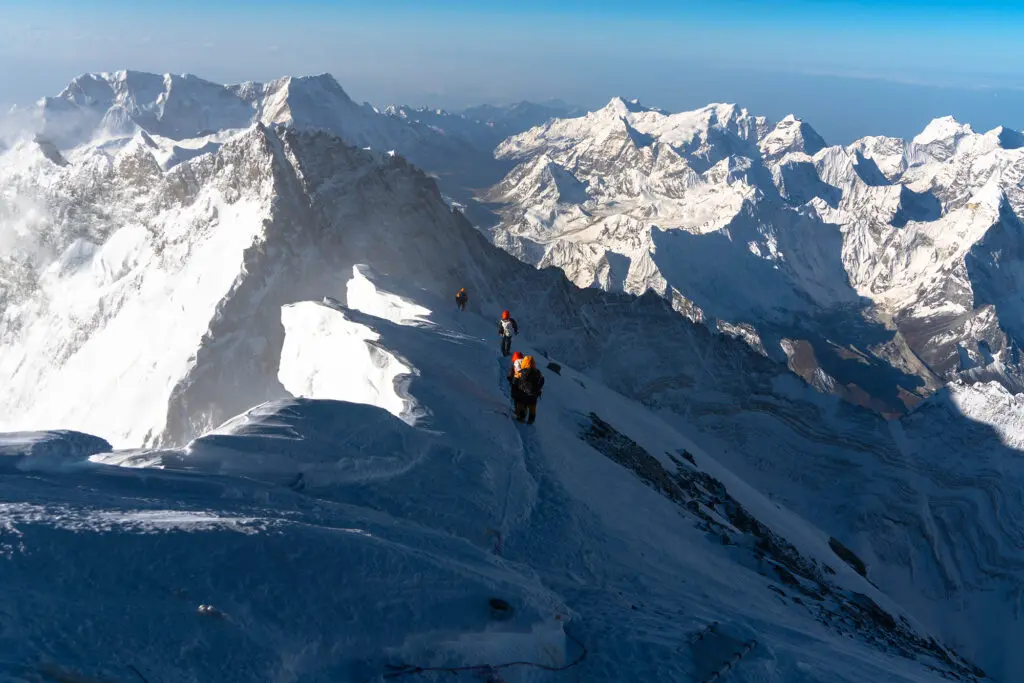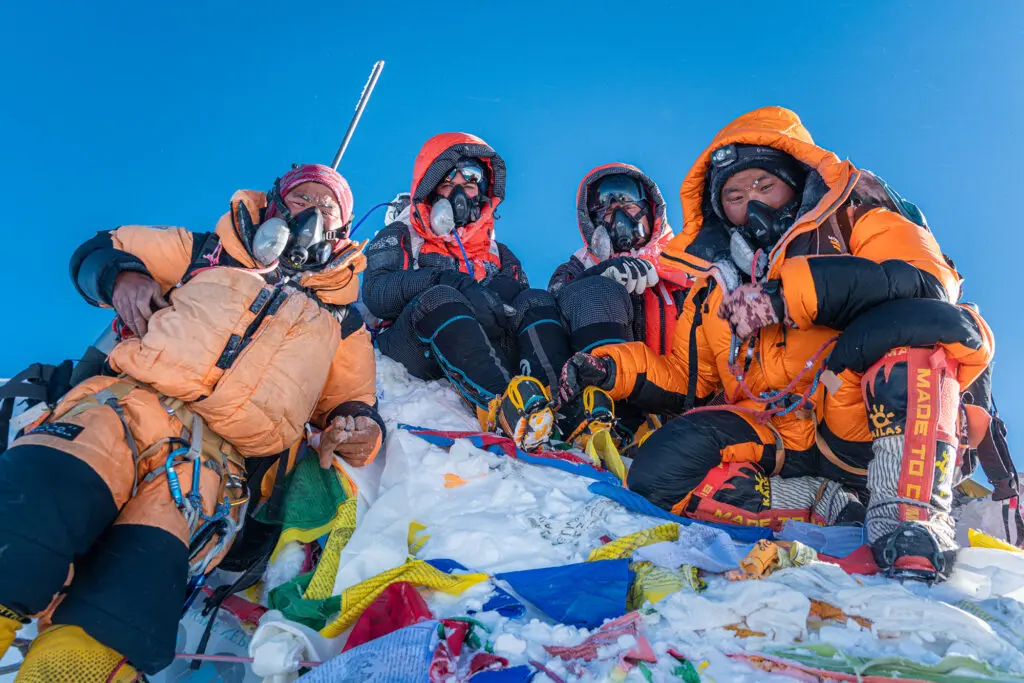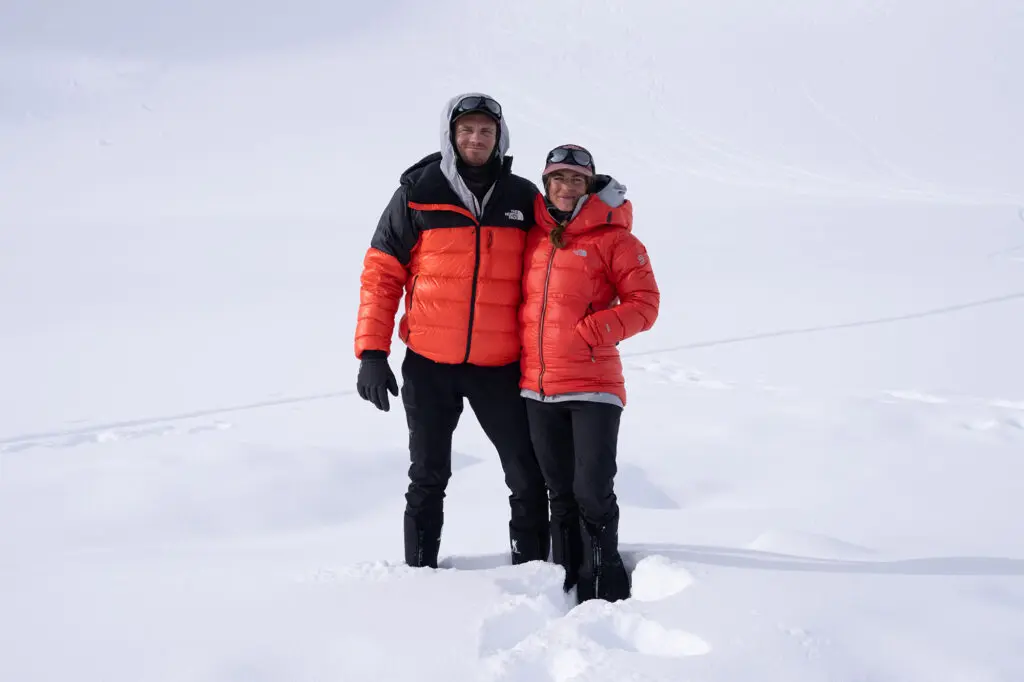Posted June 13, 2023 | By Diane Herbst | The Messenger
See Original Article Here: https://themessenger.com/news/deaf-couple-make-history-at-mt-everest-summit-most-rewarding-feeling-in-the-world-exclusive
Shayna Unger and Scott Lehmann are well on their way to conquering the seven tallest peaks on all seven continents — and quieting naysayers on their way to the top
Scott Lehmann couldn't breathe.
It was 1 a.m. on the morning of May 22, and he and his girlfriend, Shayna Unger, had already climbed 27,500 feet above sea level, closing in on the summit of Mount Everest.
Lehmann was frightened, so he tapped a Sherpa on the shoulder to let him know he was having trouble catching his breath.
"I was really struggling," Lehman, 34, tells The Messenger using American Sign Language (ASL) and an interpreter.
The couple, who are both completely deaf, don't communicate with spoken words, so they'd taught their Sherpas ASL phrases weeks before they started a climb to the top of the world's highest peak — and it came in handy on that cold morning when Lehmann had to remove his mask.
He became dizzy and his vision blurred.
“That was a scary moment for me as well,” Unger, 31, tells The Messenger, also using ASL. “Seeing that he's unable to breathe, and what can I do to help?”

Mingma Tenje Sherpa,Scott Lehmann, Shayna Unger and Mingma Dorchi Sherpawere on Mount Everest on May 22.Migmr Dhondup Sherpa
The Sherpa calmly gave Lehmann his mask, while deftly working to remove a chunk of ice from the airway on Lehmann's gear.
Once the mask was working again, the indomitable couple and their Sherpas continued onward.
That morning at 6 a.m., Lehmann and Unger held hands and bent down together to touch an icy spot at 29,032 feet elevation.
In that moment, Lehmann became the first deaf American man and Unger the first deaf woman ever to reach the summit of Mount Everest.
“It’s hard to believe that we’re there, standing there,” Unger says of their historic climb.

Shayna Unger and Scott Lehmann with their Sherpas at the summit of Mount Everest at 6 a.m. on May 22.Migmr Dhondup Sherpa
The couple spent 30 minutes at the top, surrounded by a breathtaking view of the Himalayan mountain range.
“It was the most rewarding feeling in the world ,” says Lehmann. “It was just really a blessing.”
Hours later, the couple — exhausted but determined, and egged on by their Sherpas — decided to summit Llotse, a mountain next to Everest that's the fourth highest in the world
After a few hours’ sleep, Lehmann and Unger scaled Llotse, reaching its 27,940-foot-high peak the following morning.
The couple had waited for good weather to make the climbs in a season considered one of Everest’s deadliest.

Scott Lehmann, left, and Shayna Unger at the summit of Llotse, the world's fourth highest mountain, on May 23.Mingma Dorchi Sherpa
Just days before the trek up Everest, a deaf climber from Malaysia they befriended at base camp became just the second known deaf person to summit Everest.
Two days later he disappeared on the mountain and hasn’t been found.
“It was really hard on us,” says Lehmann. “We had connected with him and had such a deep bond.”
The couple attributes rigorous physical conditioning and meticulous planning for their safe Everest climb.
Plus, they have plenty of experience. Lehmann and Unger's other triumphs include scaling many of the world’s tallest peaks — including Kilimanjaro in Africa, Aconcagua in the Andes of South America and Denali in Alaska, as well as other major mountains across the globe.
These feats are all the more impressive considering the obstacles they’ve overcome on their way to the top.
“A lot of people feel like deaf people on the top of the mountain, that we don't belong there,” says Unger.
“It feels like we defied all odds to be able to get to this point,” she says, “showing that deaf climbers are just like everyone else.”

Scott Lehmann, left, and Shayna Unger using American Sign Language to discuss a route to the top of Mount Everest.Saroj Fagami Magar
Lehmann and Unger — both of Frederick, Maryland, where they now live together with family — were born completely deaf to deaf parents.
Each have deaf siblings, as well as aunts, uncles and grandparents who are also deaf.
The couple met at the Maryland School for the Deaf in Frederick when Unger was 14 and Lehmann 17. They later became a couple while both were attending Gallaudet University.
While each had a lifelong love of nature, neither had considered mountaineering, with no role models to show them it could be done.
“We didn't see anyone doing it while we were growing up,” says Unger.
In 2102, Lehmann was 22 and newly graduated from college. He and a few pals — all deaf — attempted to take climbing lessons near Mount Rainier in Washington State.
When told they had to pay for an American Sign Language interpreter to accompany them up the mountain and liability insurance for the interpreter, they nixed the idea.
The group attempted — and failed — to reach the summit on their own.
But Lehmann had caught the bug for climbing.
“I went to YouTube and I tried to learn as much as I could,” he says. With no lessons available for deaf students, he is entirely self taught. “It was a very long, hard journey.”

Shayna Unger repelling at the Khumbu Icefall on Everest on April 25.Saroj Fagami Magar
During a 2015 trip to Tanzania with Unger, Lehmann suggested they climb a mountain together.
“I’m like, ‘What? Climb this mountain? I’ve never climbed a mountain,’” she recalls. “He said, ‘Don’t worry, I’ll teach you. You will be fine.’ ”
Unger’s first climb was Mount Kilimanjaro, Africa's highest peak at 19,341 feet high.
“I really enjoyed it,” she says. “And we just kept climbing. We enjoy finding these remote places and adventures. I think that helped us kind of fall in love together.”

Shayna Unger and Scott Lehmann met as high school students in Maryland and began dating while attending Gallaudet University in Washington, D.C.Migmr Dhondup Sherpa
To communicate on the mountain, they use ASL and five-fingered gloves, rather than mittens.
While at the Everest base camp, they taught their Sherpas basic sign language to communicate.
“They picked it up so quickly,” Unger says, “we were having normal conversations back and forth.”
While these Sherpas welcomed working alongside the couple, over the years the pair discovered many in the climbing world believe deaf mountaineers are “a liability,” says Lehmann.
“They usually see them as ‘Oh, you can't hear well in the outdoor world, this is an unsafe situation,' ” he says.
They’ve have had guides cancel entire expeditions upon learning they can't hear.
“So usually when we're going on a trip, we don't tell the guide that we're deaf until we meet them,” Unger says, “and we already have everything in a plan.”
It wasn’t until the Lehmann and Unger’s 2021 climb of Alaska’s 20,310-foot-tall Denali — the first all-deaf expedition to summit the highest peak in North America — that they thought to take on Everest.
Last year they left their full-time jobs at the Maryland School for the Deaf, where Unger was a school counselor and Lehmann taught math, to secure funding from sponsors and train full-time for the feat.
They also announced a goal to become the first deaf people to climb the highest mountains in every continent in the world, known as the Seven Summits. (They have three more to go.)

Shayna Unger, left, and Scott Lehmann at the summit of Mount Everest at 6 a.m. on May 22, 2023.Migmr Dhondup Sherpa
They are already admired in the deaf community as role models, and hope this project, which they called Seeing Beyond, will inspire deaf people, particularly children, to pursue their dreams.
They frequently post videos and host Q&As in ASL on their Instagram page, @scottandshayna, about their experiences, and give talks at deaf schools.
They want to encourage kids to realize, "'Oh wow, I can do this,' " says Shayna.
And while reaching the world's highest peaks attracts the most attention, that’s not what climbing is about for the couple, who say they're holding out for an engagement until they've conquered the Seven Summits.
Says Lehmann: "It's more about the whole entire journey that it takes to get there."